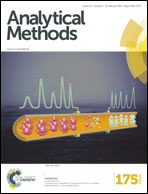Determination of sarafloxacin and its analogues in milk using an enzyme-linked immunosorbent assay based on a monoclonal antibody
Abstract
A heterologous immunoassay has been developed for the determination of sarafloxacin (SRFX) and its analogue residues in milk. A novel hapten with molar mass 499 g was synthesised by introducing a six carbon molecule [6-bromohexanoic acid (BR)] as a spacer arm. This greatly improved the effect of SRFX inducing immune response in mice and enhanced the chance of producing a monoclonal antibody capable of recognising analogues to SRFX. The synthesised hapten [7-(4-(5-carboxypentyl)piperazin-1-yl)-6-fluoro-1-(4-fluorophenyl)-4-oxo-1,4-dihydroquinoline-3-carboxylic acid (SRFX-BR)], to induce an immune response, was conjugated to bovine serum albumin (BSA) (SRFX-BR-BSA) via the carbodiimide active ester method while the mixed anhydride reaction was used to prepare the coating antigen [SRFX conjugated to ovalbumin (OVA) (SRFX-OVA)] to pursue the heterologous sensitivity. Based on the checkerboard titration, an indirect competitive enzyme-linked immunosorbent assay (icELISA) was developed for the quantitative detection of SRFX and three of its analogues in cattle milk. After optimisation, the immunoassay was found to tolerate up to 15% methanol at a physiological pH (7.4) and a salt (NaCl) concentration of 1.2%. The results of this assay showed a good cross-reactivity to tosufloxacin (64.94%), nadifloxacin (58.14%), pazufloxacin (42.02%), fleroxacin (40.04%), pipemidic acid (34.25%), and ofloxacin (20.08%). These findings demonstrated that the immunoassay is able to detect FQs in milk samples.



 Please wait while we load your content...
Please wait while we load your content...